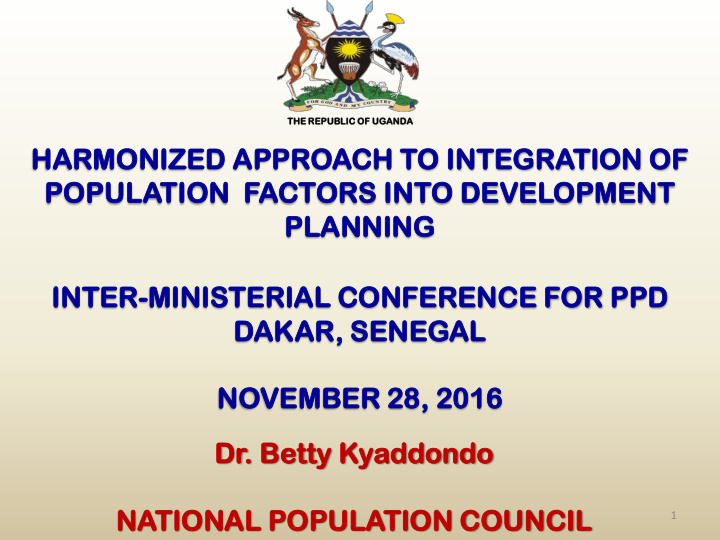



THE E REPUBL BLIC OF UGAND NDA A HARM RMONIZED NIZED APP PPROACH CH TO INTEG EGRA RATION TION OF POPU PO PULATIO TION N FACT CTOR ORS S INTO O DE DEVE VELOPM PMEN ENT T PL PLANNING NING INTER ER-MINIST INISTER ERIAL IAL CO CONFER EREN ENCE CE FOR PPD PPD DAKA KAR, R, SE SENEG EGAL NOVE VEMBER ER 28 28, 20 2016 16 Dr. Bet Dr etty ty Kyad addondo ondo NATIO TIONAL AL PO POPU PULATIO TION N CO COUNCIL CIL 1
Rapid pid Pop opul ulation tion Grow owth th sl slow ows s de development lopment 120 104.0 100 84.0 Millions of people 80 54.7 60 36.6 40 24.2 16.7 12.6 20 9.5 6.5 5.0 0 1948 1959 1969 1980 1991 2002 2014 2025 2040 2050 Population growth rate at 3.2% per annum 2 2
Inte Integrating ting Popula opulation Dy tion Dynamics in namics in De Development elopment Framew amewor orks ks Government recognizes that population is the most important asset of a nation - NPP 2010 Since FY 2010/11 there are focused efforts for integrating population dynamics in development planning. o NDP I (2010); Population dynamics recognized as constraining factors. o NDP II (2014); Population dynamics recognized as both a cross cutting issue as well as a strategy (Demographic Dividend) for attaining Vision 2040. Integrating population dynamics in development planning is not matched with budgetary allocations for population intervention priorities. 3
NATION IONAL L DE DEVEL ELOPMENT OPMENT FR FRAME MEWORKS ORKS 1. Vision 2040 2. National Development Plan II 3. Sector Development Plans 4. Local government Development Plans
Integration of Population and Dev evelopment in Planning Fra rameworks Uganda’s Long -Term Development Vision 1. Integration of population issues into NDF is done upstream in the including Population development of the framework. 2. Takes into consideration all population issues identified by the development sectors. NDP 3. Each development sector identifies issues for integration by specific Medium/Short-Term population segments. 4. Ensures coherence within each sector and between sectors regarding S population issues. Based on various Lands and Housing Labour and Social Development E objectives, strategies, the target Water and Environnent C population segments and their Education projection in various timeframes. T Agriculture O Economic Management 5. Complies with the NATIONAL VISION Health R and keeps in mind the attainment of A clear results for Medium and Long- Local Government Term Goals. L Works and Transport 5
Three ee levels els of Inter terventio ention 1. Macro/ National: The "macro" level brings together the different situations in a aggregate view without highlighting the specificities such as the situation of the minorities, the specificity of the individual districts. It’s an average view of the "national" situation. Macro Level 2. Sectoral /sub national: Understood in 2 non-exclusive ways: The sectoral issues with obvious connection to the national but specific to sectoral issues. The sub-national issues are approached through Sectoral/ decentralization or geographical strategies; and Sub-national 3. Micro: The "micro" or "local" level is the community level or grassroots level which deals with issues that directly affect the people in their day to day life but in relation with population concerns (communes, villages, etc.). This is the level where development Micro/ Local Level actually takes place in terms of directly touching the beneficiaries. 6
LOCA CAL L GOVE VERNMEN MENT T DE DEVE VELOPM PMEN ENT T PL PLANNING NING PR PROCE CESS SS LGDP Process consists of three (3) main stages mainly: Stage 1: Consultation and Data Collection Stage 2: Plan Formulation (critical issues for integrating population variables) Conduct Population Situation Analysis Data Collection Setting Goals. Objectives and Targets Set Strategies Identify Interventions and budgets Stage 3: Approval of LG Development Plans. 7
Key inte ey integration tion Challenges Challenges Inadequate understanding on the interrelationships between population and sustainable development – low appreciation of the impact of population issues on development and environmental sustainability. Limited funding specifically for implementation of population activities at National (NPPAP) and LGs (DPAPs). Low institutional and technical capacities of sectors and LGs to integrate population variables into the development plans and budgets. Limited systematic coordination and M&E of population interventions. 8
Lessons Lessons Lear Learnt nt 1. Successful integration calls for continuous interactions with the sectors and Local Governments at all stages of the planning process, budgeting cycle and in sector policy formulation and review. 2. There is need to create a critical mass of technical officers at Sector and Local Government level (through capacity building) - to propose interventions and strategies and budget for population activities. 3. Integrating population dynamics into development frameworks is not sufficient without budgetary allocations for population interventions. 9
Thank Y hank You ou 10
Recommend
More recommend